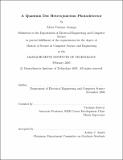A quantum dot heterojunction photodetector
Author(s)
Arango, Alexi Cosmos, 1975-
DownloadFull printable version (2.897Mb)
Other Contributors
Massachusetts Institute of Technology. Dept. of Electrical Engineering and Computer Science.
Advisor
Vladimir Bulović.
Terms of use
Metadata
Show full item recordAbstract
This thesis presents a new device architecture for photodetectors utilizing colloidally grown quantum dots as the principle photo-active component. We implement a thin film of cadmium selenide (CdSe) quantum dot sensitizers, sandwiched between an electron-transporting titanium dioxide (TiO2) layer and a hole-transporting N,N' diphenyl-N,N' bis(3-ethylphenyl)-(1,1'-biphenyl)- 4,4'-diamine (TPD) organic small molecule layer. The wide band gap TiO2 and TPD layers are found to block charge injection under reverse bias, yet serve as transport layers for photo-excited charge generated in the CdSe. The internal quantum efficiency is approximately 1% at zero bias and saturates at 3% at -1V. Current-voltage sweeps yield low dark current in reverse bias and significant hysteresis under illumination. We speculate that the hysteresis and low quantum efficiency are due to charge accumulation at the TiO2/CdSe interface.
Description
Thesis (S.M.)--Massachusetts Institute of Technology, Dept. of Electrical Engineering and Computer Science, 2005. This electronic version was submitted by the student author. The certified thesis is available in the Institute Archives and Special Collections. Includes bibliographical references (p. 113-119).
Date issued
2005Department
Massachusetts Institute of Technology. Department of Electrical Engineering and Computer SciencePublisher
Massachusetts Institute of Technology
Keywords
Electrical Engineering and Computer Science.